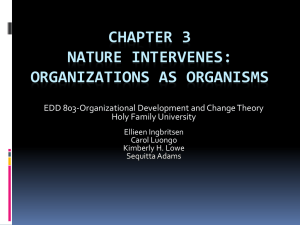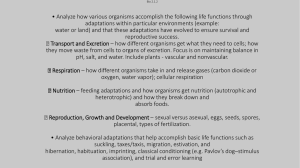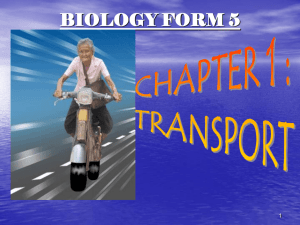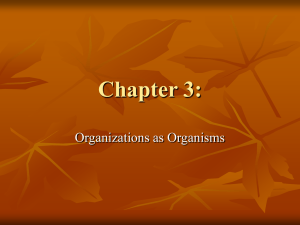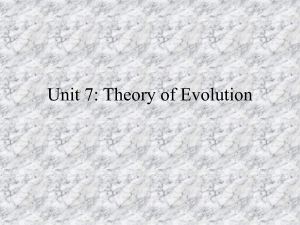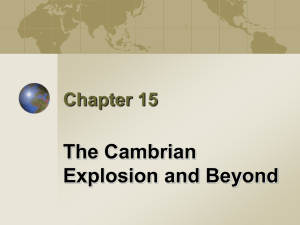Fossils
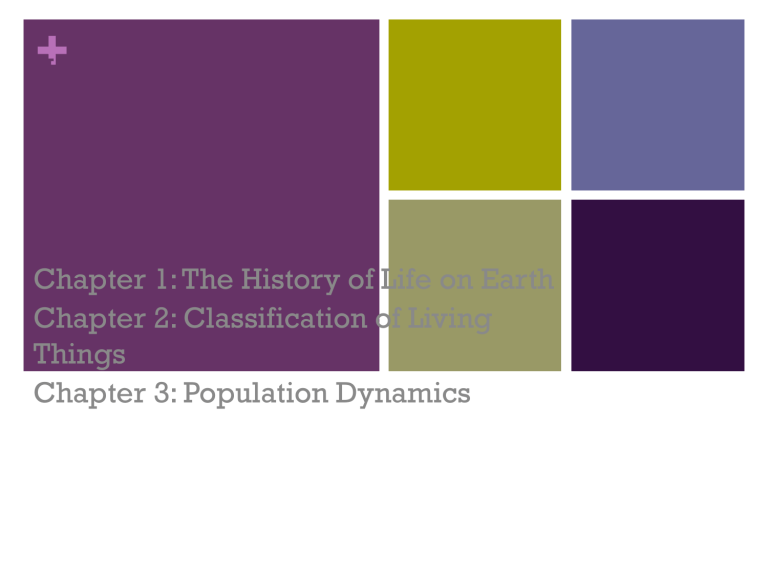
Chapter 1: The History of Life on Earth
Chapter 2: Classification of Living
Things
Chapter 3: Population Dynamics
+
Chapter 1: The History of Life on
Earth
1.1 Earth has been home to living things for about 3.8 billion years
1.2 Species change over time
1.3 Many types of evidence support evolution
+
1.1 Earth has been home to living things for about 3.8 billion years
Before, you learned:
Living things are diverse
Living things share common characteristics
A species is a group of living things that can breed with one another
Now, you will learn:
How scientists use fossils to learn about the history of life
About patterns in the fossil record
About mass extinctions
+
Fossils provide evidence of earlier life
A movie set to 3.8 billion years ago: oceans
Fossils – the remains of organisms preserved in the Earth
A glimpse of a very long story – like a pause button
Imprints or remains of once-living things
Fossils provide evidence of earlier life
Assembling the Fossil Record
Combine absolute and relative dating to estimate the age of most fossils
Used to develop an overview of Earth’s history
+
More Complex organisms developed over time
Seen in the fossil record – reconstruct history to show:
how life has developed over time how organisms have evolved into more complex forms
Fossil evidence shows the first living things were simple prokaryotes (unicellular, no nucleus)
The Earth has changed over time, so have the organisms that lived on it
Some of the organisms have helped change the conditions on
Earth
time -
Early Forms of Life
4.6 billion years ago, Earth was too hot to support life
The surface cooled and a solid crust formed
Gases such as methane and carbon dioxide formed an atmosphere
little nitrogen or oxygen
Earth’s surface slowly cooled enough for oceans to form
3.8 billion years ago: conditions were still harsh compared to today
Earth now could support simple life forms:
Simple prokaryotes called cyanobacteria (SY-uh-noh-bak-TEER-eeuh)
Responsible for the oxygen in the atmosphere
+
More Complex organisms developed over time -
Early Forms of Life cyanobacteria
Lived in huge groups that formed enormous mats
floated on the surface of the ocean or covered parts of the sea floor
Produced a mucous/glue – collected sediments – formed layers:
“stromatolites”
Contained chlorophyll and used photosynthesis to make sugars from carbon dioxide, producing oxygen
oxygen levels in the atmosphere increased while methane and ammonia levels decreased
By 2 billion years ago, there was enough oxygen to support a new life form—eukaryotes
+
More Complex organisms developed over time -
Multicellular Organisms
As oxygen levels increased, organisms that used oxygen thrived
Had structures that used the oxygen to release energy stored in sugars = mitochondria
Mitochondria – possibly once free-living cells on their own!! first eukaryotes
Then the mitochondria used oxygen to get energy from sugars.
Oldest known fossils of eukaryotes: algae ~2 bya– single celled
Evolution from one cell to many…possibly…
Different types of eukaryotes were better at certain tasks
Ex: movement or digestion
Many cells grew in colonies
Cells from different colonies may have fused together, forming the first multicellular eukaryotic organisms
In time, evolved into larger organisms
The oldest fossils of multicellular organisms are from tiny algae ~1.5 bya
By 600 mya the first multicellular animals —jellyfish-like organisms—had evolved
+
More Complex organisms developed over time –
on Land
Life
About 460 million years ago, the first multicellular organisms moved from water to land
Recall: cells need water to carry out life processes
Organism in water doesn’t dry out!
Need new ways to help the cells get water
First organisms to come ashore lived in moist areas – shorelines
First plants evolved from algae
Water from soil through roots
Leaves covered with waxy substance to prevent drying
Simple plants and fungi, obtaining water from the soil through roots
Insects – food and shelter by plants
Followed by amphibians, reptiles, birds, and mammals
+
More Complex organisms developed over time –
on Land
Life
Insects: first terrestrial (land-dwelling) animals ~400 mya
probably evolved from hard-shelled aquatic animals, such as crabs bodies had a tough waxy covering that protected them from drying out
Could take in oxygen from the air instead of from the water
Over time, bacteria, algae, plants, fungi, and insects began to spread to new habitats
Conditions in these habitats changed as the Earth changed
New life forms evolved
Interactions between organisms and Earth
Supported more complex multicellular life
+
Earth’s history includes mass extinctions
Many new forms of marine, or ocean-dwelling, invertebrates evolved during the Cambrian period (544–505 million years ago)
first sharks and other fish
“Cambrian Explosion“
Mass extinction - a period when huge numbers of species have died or become extinct in a very short time
The fossil record shows at least five two most interesting and best studied: Permian and Cretaceous
+
Earth’s history includes mass extinctions
From the Cambrian through the Permian (286–248 mya) – explosion of new species
Oceans: great diversity: corals, jawless fish, and fast-swimming squid-like animals.
End of the Permian: 95% of species = extinct
largest mass extinction in history
Possible explanations:
Both carbon dioxide levels and global temperatures began to rise – lowering sea levels, destroying marine ecosystems
high levels of volcanic activity
large amounts of volcanic ash into the atmosphere
preventing sunlight from reaching the surface
+
Earth’s history includes mass extinctions
Cretaceous period ~145 mya – Earth filled with different species
Diversity of plants and animals
The earliest mammals had evolved
The dominant group of land animals: the dinosaurs
…80 million years later, the dinosaurs were gone!
Exinction in as little as 2 million years
More than ½ of the other species extinct as well
65 mya: a very large object from space collided with Earth
Likely wiped out most of the life forms on Earth
ended the Cretaceous period formed Chicxulub Crater, a 200-kilometer-wide crater that lies off the coast of Mexico


